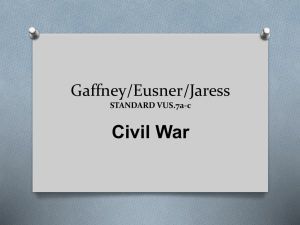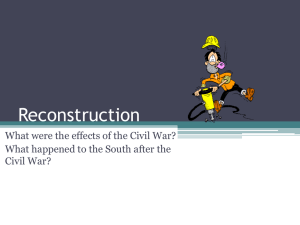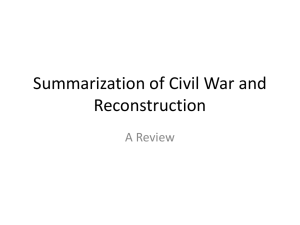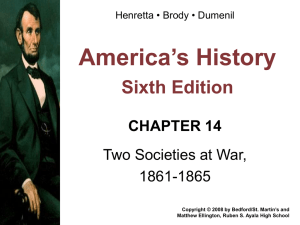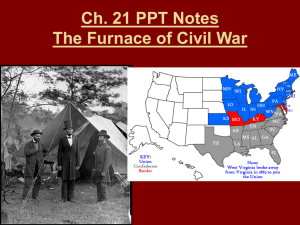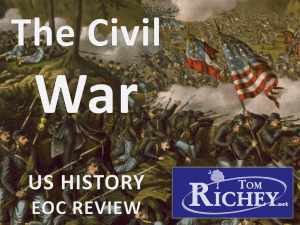Causes & Effects of the Civil War
advertisement
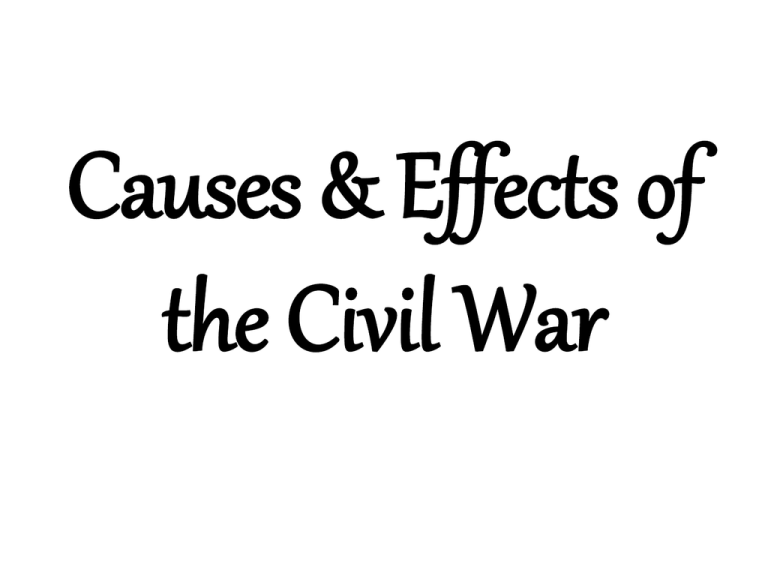
Causes & Effects of the Civil War Economic Differences • South – “cotton kingdom” – Plantation system • Slave labor – Agricultural – Anti-Clay’s “American System” • National Banking • Internal improvements • tariffs • North – Manufacturing & factory system – Used of immigrants for labor in new factories – Pro-Clay’s “American System” Political Causes • States’ Rights • Wilmot Proviso (no slavery in Mexican territory) • Compromise of 1850 – CA added as free state & other territory popular sovereignty & fugitive slave laws • Kansas-Nebraska Act – Popular vote in territory on slave issue – “Bleeding Kansas” – Caning of Senator Sumner • Dred Scott v. Sanford • Republican Party & Election of 1860 • Fort Sumter Social Causes • Second Great Awakening • Abolition Movement: – Frederick Douglass & Up from Slavery – William Lloyd Garrison & The Liberator – Sojourner Truth • Rebellions: – Nat Turner: slave rebellion – John Brown’s Raid • Women’s Rights Movement – Seneca Falls Conference (Susan B. Anthony, Elizabeth Cady Stanton) – Declaration of Sentiment of Rights The War Starts… • February 4, 1861—Confederate States of America was born • Fort Sumter was one of few Union footholds in the South – – – – Lincoln’s dilemma: order attack on the fort evacuate the fort “food for hungry men” • Jefferson Davis’ dilemma: – do nothing – order attack on the fort** • Confederates attacked and the fort fell out of the Union control • RESULT: United the North; Virginia and other upper Southern states seceded *1863: West Virginia was created • Both sides expected a short, glorious war, but got a blood bath that lasted until 1865. Both sides were passionate and that it was right. The War Continues Lincoln Abuses His Power… (Ch. 20) • Writ of habeas corpus – Latin for “you have the body” – Gave judges the power to command the presence of a person before court. • Both accused & accuser must appear before court • It required government to explain WHY a person was being detained. • Congress was not in session; Lincoln acted on his own authority to suspend habeas corpus during the Civil War, arguing Article I, Section 9 of the Constitution Group Activity: e In groups of 2-3, you need to read through the documents on “The Suspension of Habeas Corpus.” One will be pro-Lincoln & his choice; the other will be anti-Lincoln & his choice. e Create a chart with 2 columns and the following headings: –Lincoln was RIGHT to suspend Habeas Corpus –Lincoln was WRONG to suspend Habeas Corpus A nation divided • Confederate States of America: – Before Ft. Sumter: • • • • • • • South Carolina Florida Georgia Alabama Mississippi Louisiana Texas – After Ft. Sumter: • • • • Virginia North Carolina Tennessee Arkansas • United States of America – – – – – – – – – – – – – – – – – – Maine Vermont New Hampshire Massachusetts Rhode Island Connecticut New York New Jersey Pennsylvania Ohio Indiana Illinois Iowa Michigan Wisconsin Minnesota California Border States: Missouri, Kentucky, Maryland, Delaware Map of the North vs. South First Years of a LONG War: 1861-1862 (Ch. 19) • Many expected a short war…few weeks • Lincoln ordered only a 90-day enlistment period • “ON TO RICHMOND!” First Battle of Bull Run (July ’61) • 1st major battle of war • Location: near Bull Run Creek (Manassas Junction, VA) • 30K Union troops marched from DC to attack Confederate forces • Union was close to victory – Confederate reinforcements under Gen. Stonewall Jackson counterattacked & sent Union troops in disorderly & panicky flight back to DC – “Rebel Yell” • IMPACT: North realized it was going to be a LONG & bloody war; South grew complacent and had trouble with deserters (felt the war was over) Anaconda Plan • Union military strategy to strangle the South by blockading its coasts • Control the Mississippi to cut of Confederacy in half • Sherman’s March to the Sea • Capture key cities in the South: Richmond, Atlanta, Charleston Eastern Theater: Peninsula Campaign (April-June ’62) • Union Gen. McClellan insisted that his troops be given a good training & discipline before heading into battle • McClellan often overcautious & exasperated Lincoln • McClellan’s army invaded VA b/t James & York Rivers vs. direct attack • McClellan met the brilliant military tactics of Confederate Gen. Lee. • McClellan was forced to retreat and ordered back over the Potomac…and replaced. • RESULT: CONFEDERATE VICTORY nd 2 Battle of BR (July ’62) • Lee took advantage of the change of Union Generals – Tricked the new Union Gen (Pope) – Struck the enemy’s flank – Sent the Union army backward toward BR – Union Gen. Pope retreated back to DC • RESULT: CONFEDERATE VICTORY • McClellan replaced Pope Antietam (Sept. ’62) • Lee invaded Maryland to take it from the Union & encourage foreign intervention (GB) on behalf of the South • McClellan knew of Lee’s plans b/c of copy of battle plans had been dropped by Con. officer. • Resulted in the bloodiest single day of battle • OUTCOME: Lee forced to retreat back into VA; McClellan removed for the final time by Lincoln for failing to pursue Lee’s weakness…militarily a DRAW between both sides • IMPACT: South didn’t receive recognition or aid from a foreign power; opened the door for Emancipation Proclamation Emancipation Proclamation • Lincoln’s declaration that freed enslaved people in the rebelling territory, but not slaves in the Union or Border States • Did Lincoln have that authority? • CONFISCATION ACT: Union army could confiscate slaves as they invaded South on the basis they were “contraband” of war Impact of Emancipation Proclamation • Many Northerners felt it went too far; opposed fighting an “abolition war” • Desertions increased from Border States • Republicans lost mid-term elections • Abolitionists thought Lincoln did not go far enough; though some pleased • South accused Lincoln of trying to stir up a slave insurrection Bell Ringer: Brainstorming Ideas • Respond to the following question by creating a thesis statement and a brief outline of key points you will make. • “The South never had a chance to win the Civil War.” Assess this statement with respect to specific military, economic, political, and social factors. Battle of Fredericksburg (Dec. ’62) • New Union Gen. Burnside recklessly attacked CSA Gen. Lee in Fredericksburg. • Union suffered deep losses • The romance fell out of war • SIGNIFICANCE: no prospect of military victory for either side Monitor vs. Merrimac (Spring ‘62) • Union tried to keep economic & naval advantages over the South • During the Peninsula Campaign, CSA was able to slip the Merrimac into the river and attack the Union wooden ships • Union countered with its own ironclad, Monitor • The 2 ships lasted for 5-hours & ended in a draw. • RESULT: Union was able to stop the South’s new weapon from breaking the blockade. Both ironclads destroyed wooden sailing ships for future of naval warfare. Foreign Affairs during the War • Trent Affair: CSA sent delegates to GB for recognition of the CSA. Union stopped ship & delegates held prisoner…later released but never gained recognition • Raiders: CSA was purchasing old ships from GB, Union stopped future sales by threatening war with GB • “King Cotton”: GB found other sources for its demand of cotton (Egypt, India) 2 Factors of GB not recognizing CSA • Failure of clear CSA victory at Antietam • Emancipation Proclamation made ending slavery the main objective for the Union. This appealed to British working class Thirteenth Amendment • Standing in the way of full emancipation was the U.S. Constitution • Process was started on passing an amendment (passed after Lincoln’s death) • Simply stated: “Neither slavery nor involuntary servitude, except as punishment for crime whereof the party shall have been duly convicted, shall exist within the United States, or any place subject to their jurisdiction.” Freedmen in the War • After the E.P., hundreds of thousands of southern slaves walked away from slavery to seek protection from approaching Union armies. • 200K African Americans fought in segregated regiments in the Union army and navy – Ex: Massachusetts 54th Regiment (Glory) The Union Triumphs (1863-1865) • Turning Points 1. Vicksburg (Spring 1863): Union controlled most of Mississippi River & New Orleans. Grant began siege against city of Vicksburg. After 7 weeks, Confederates surrendered the city. Union now controlled Mississippi & cut TX, LA, & Ark. from rest of Confederacy 2. Gettysburg (July 1863): Lee took offensive leading an army into Maryland; 3 day decisive battle of the war; went back and forth b/t USA & CSA; Lee retreated & never regained the offensive • • • • Gettysburg Address Four score and seven years ago our fathers brought forth on this continent, a new nation, conceived in Liberty, and dedicated to the proposition that all men are created equal. Now we are engaged in a great civil war, testing whether that nation, or any nation so conceived and so dedicated, can long endure. We are met on a great battle-field of that war. We have come to dedicate a portion of that field, as a final resting place for those who here gave their lives that that nation might live. It is altogether fitting and proper that we should do this. But, in a larger sense, we can not dedicate -- we can not consecrate -- we can not hallow -- this ground. The brave men, living and dead, who struggled here, have consecrated it, far above our poor power to add or detract. The world will little note, nor long remember what we say here, but it can never forget what they did here. It is for us the living, rather, to be dedicated here to the unfinished work which they who fought here have thus far so nobly advanced. It is rather for us to be here dedicated to the great task remaining before us -- that from these honored dead we take increased devotion to that cause for which they gave the last full measure of devotion -- that we here highly resolve that these dead shall not have died in vain -- that this nation, under God, shall have a new birth of freedom -- and that government of the people, by the people, for the people, shall not perish from the earth. Union changes command…again…Grant • After wins in the West, Grant was named commander of ALL the Union Armies & moved to Virginia. • Grant realized the South’s supplies were quickly running out & systematically began to wear down the South • Warfare changed and trenches were used • No longer was this a war “between gentlemen” but a total modern war against civilians as well as soldiers. 1864…war winds down • Sherman’s March (Sept ‘64 to Feb ‘65): Started from Chattanooga to Atlanta to Savannah to Columbia & north; army of 100K destroyed everything in its path—everything the CSA could use to survive • IMPACT: broke the will of the South & its ability to fight on Election of 1864 • Republican: Abraham Lincoln (i) • Democrat: Gen. George McClellan The End of the War • Effects of blockade, Sherman, spread hunger in much of the South • Grant continued to outflank Lee’s army until they collapsed @ Petersburg followed by Richmond (April 1865) • Confederate army surrounded near Appomattox Court House in VA • April 9, 1865Lee surrendered to Grant Assassination of Lincoln • April 14, 1865 John Wilkes Booth shot Lincoln @ the Ford’s Theater – Conspirator attacked Sec. of State Seward Write and Share: With a partner (or two) respond to the following question. IDENTIFY AND ANALYZE SEVERAL IMPORTANT FACTORS THAT LED TO THE CIVIL WAR. Effects of the War on Civilian Life POLITICAL, ECONOMIC, & SOCIAL CHANGE Political Change • Electoral process continued during the War • Civil Liberties: during the war, the gov was more concerned w/ war than protecting citizens’ constitutional rights – Ex Parte Milligan (1866): Supreme Court ruled that the gov acted properly in Indiana where some citizens had been subject to military trials • Draft: started w/ volunteer force, later conscription of those 20-45 yrs old; find suitable substitute or pay $300 fee Political Change (cont.) • Long-term effects: balance of power shifted between the North and South • After the C.W., the supremacy of the federal government over states was treated as an est. fact. • Abolition of slavery gave new meaning and legitimacy to the concept of American democracy Economic Change • North financed the war ($2.6 BILLION) by the sale of government bonds. Still not enough: – Raising tariffs (Morrill Tariff); adding excise taxes; and instituting the first income tax – Greenbacks: issued by U.S. Treasury but not redeemable for gold; led to inflation • Modernizing northern economy: no real significant change; CON: workers’ wages did not keep up w/ inflation; PRO: modernized and consolidated the industries Economic Change (cont.) • Republicans in Congress passed ambitious economic programs: – National banking system – Morrill Tariff Act: raise revenue & protect American businesses – Homestead Act: promoted settlement in Great Plains by offering 160 acres if ind/family farmed it for 5 years – Morrill Land Grant: encouraged states to use sale of federal lands to maintain ag & tech colleges – Pacific Railway Act: transcontinental RR • Women: Social Change – Filled in for men who were off fighting (fields, factories, offices, stores, gov) in North & South – Served as military nurses • Effects: – Field of nursing opened to women – Opened the door for equal voting rights Social Change (cont.) • Biggest group impacted: former slaves (3.5 in South, 500K in border states) – 13th Amendment banned slavery • Tragic human loss as result of war: – 620K men died – $15 billion in war costs & damaged property – Destroyed slavery and southern economy • Catalyst for transformation to modern industrial society Chapter 22 RECONSTRUCTION Reconstruction? • YEARS: 1865-1877 • Attempt to achieve national reunification and reconciliation after the Civil War and improve life of former slaves • 4 Questions to answer: 1. 2. 3. 4. How to rebuild the South? What would be the condition of the A-A in the South? How would the South be integrated into the Union? Who would control the process: Southern states, president or Congress? Q#1: How to rebuild the South? • Passing of the 13th, 14th, & 15th Amendments were passed – Outlawed slavery (13) – Defined a citizen (14) – Suffrage regardless of race or color (15) • Major Southern cities destroyed – Banks, factories, transportation in ruins – Cotton fields were full of weeds Q#2: What would be the condition of the A-A in the South? • Freedmen’s Bureau: to help the unskilled, uneducated, poverty-stricken ex-slaves to survive (social services, medical care, etc) Q#3: How would the South be integrated into the Union? • Southern states had – to ratify the 13-15th Amendments – Swear allegiance to the US – Obey emancipation Q#4: Who would control the process: Southern states, president or Congress? • Lincoln and Congress had varying views on what to do with the rebelling states: – Lincoln: recognize a new state gov; 10% of exConfederate voters to pledge loyalty of the US and obey emancipation – Congress: 50% ex-Confederate voters to pledge loyalty; iron-clad oath; saw CSA as “conquered territory” and subject to Congress’ conditions and wishes Reconstructing Society • Physical and Economic Conditions – Buildings, infrastructure, farms destroyed throughout South – People poor; property value plummets, Confederate bonds worthless – 1/5 white males dead, many maimed; tens of thousands black males dead • African Americans as Voters – African Americans are largest group of Southern Republicans Society during Reconstruction • Politics and African Americans – 1865–1877, African Americans hold local, state, federal office • Sharecropping and Tenant Farming – Landless African Americans sign labor contracts with planters - neither freedmen nor planters happy with system Sharecropping—owner gives land, seed, tools for part of crops Tenant farming—rent land from owner; buy own tools Collapse of Reconstruction • Ku Klux Klan – Ku Klux Klan (KKK)—Confederate veterans group that turns terrorist – Grows rapidly; aims to restore white supremacy • The Panic of 1873 – Business opportunities in South lead investors to excessive debt – Largest government securities dealer bankrupts, starts panic of 1873 – banks, businesses close; stock market collapses – Panic triggers 5-year economic depression Ending of Reconstruction • Election of 1876 – Republicans nominate Governor Rutherford B. Hayes, not Grant – Democrats choose Governor Samuel J. Tilden – Tilden wins popular vote, 1 shy of electoral; 20 electoral disputed • Compromise of 1877—Hayes gets presidency, Democrats get: - federal troops leave LA, SC - funding for Southern railroad, waterways - conservative Southerner in cabinet – Compromise means end of Reconstruction Legacy of Reconstruction • Republicans fail to protect rights they gave to former slaves • Unwillingness to distribute land blocks economic independence • Amendments abolish slavery, give basis for civil rights legislation • African-American schools, civic groups increase literacy, opportunity
